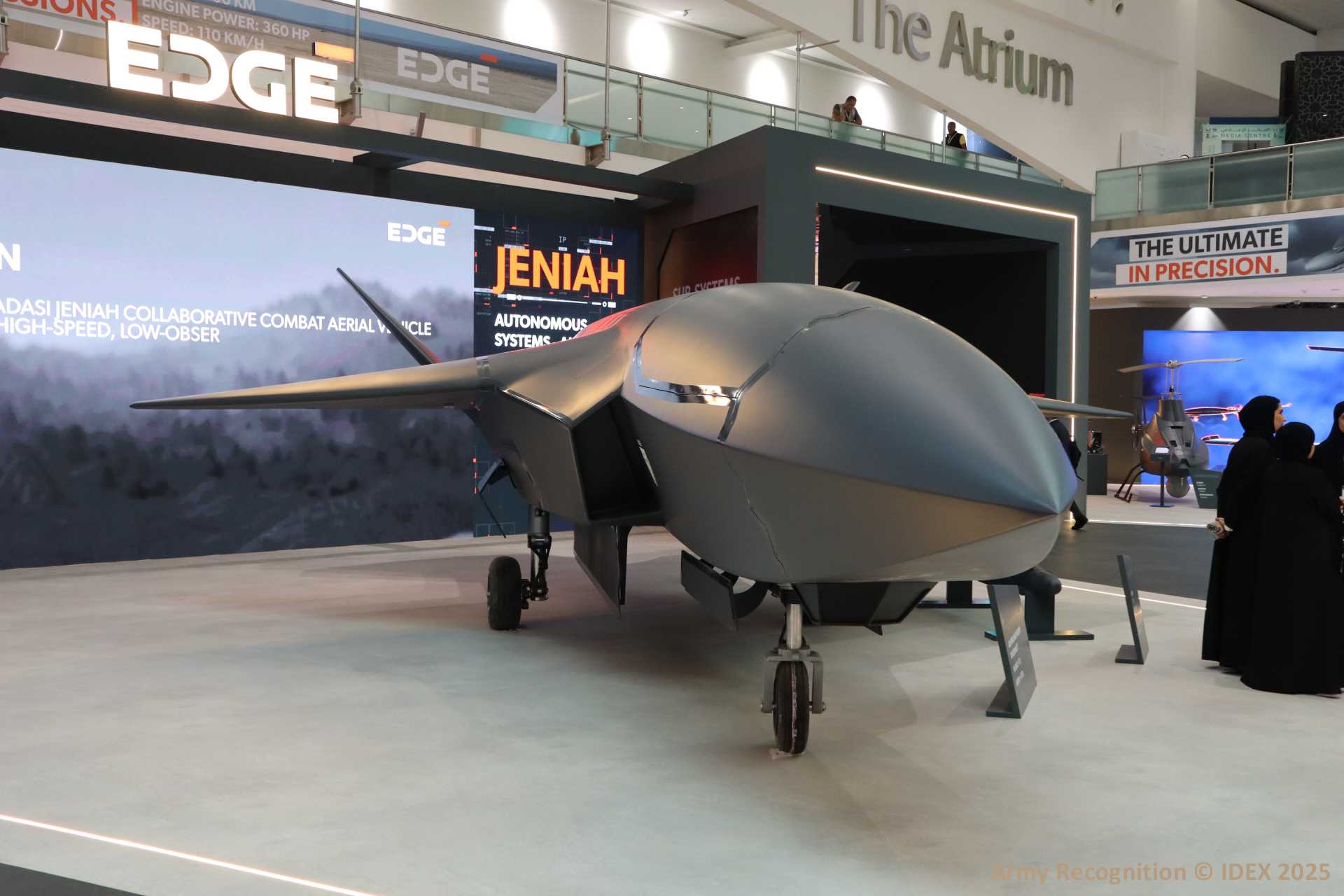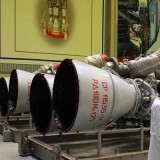Discover how the Jeniah became UAE’s first jet-powered combat drone

{loadposition bannertop}
{loadposition sidebarpub}
The Emirati Edge Group presented its new Jeniah unmanned combat aerial vehicle (UCAV) at IDEX 2025 as part of the UAE’s focus on taking part in the development of future air combat strategies. Developed by EDGE subsidiary ADASI, the Jeniah is a high-speed, low-observable UCAV designed for multi-domain operations. Its configuration enables deployment in land and maritime missions, incorporating technology suited for various operational requirements.Follow Army Recognition on Google News at this link
The Jeniah is designed for autonomous and semi-autonomous missions, utilizing artificial intelligence for target identification, navigation, and mission execution. (Picture source: Army Recognition)
Edge Group developed the Jeniah over a three-year period, culminating in its first test flight on March 15, 2024, at the X RANGE testing facility in Abu Dhabi. During this flight, the UCAV demonstrated autonomous operational capabilities and achieved a speed of 1,050 km/h. This test marked the first flight of a domestically-produced jet-powered UCAV in the UAE. The Jeniah is powered by an undisclosed jet engine and includes artificial intelligence features, though the specific role of AI in its operations remains unspecified.
The Jeniah is designed for autonomous and semi-autonomous missions, utilizing artificial intelligence for target identification, navigation, and mission execution. The UCAV is optimized for networked warfare, operating independently or in coordination with other unmanned and manned assets. It is equipped for offensive strikes, surveillance, and battlefield support in contested environments, aligning with anti-access and area denial (A2/AD) strategies. It can function solo or in group formations and is capable of operating in high-threat areas with minimal communication requirements, using AI to assist in decision-making and situational awareness.
Edge Group continues to assess the Jeniah’s performances, with additional flight testing and potential applications in international defense markets, as the aircraft is also considered for future manned-unmanned teaming (MUM-T) applications, as air forces explore integrating unmanned platforms alongside fighter jets. However, to date, the Jeniah is not planned for integration into the UAE’s Rafale F4 fleet, but potential adaptations for the Rafale F5 and discussions with European manufacturers indicate possible future collaboration. Dassault Aviation is integrating the nEUROn UCAV into the Rafale F5 program, reflecting an industry-wide move toward increased use of unmanned aerial assets in future combat operations. The UAE Air Force and Air Defense (UAEAF&AD) is evaluating the role of MUM-T in its operational strategy to enhance combat effectiveness and reduce risks to personnel.
The Jeniah has a maximum takeoff weight of over 4,000 kg, a wingspan of 7 meters, and a length of 11 meters. It can carry payloads up to 480 kg, including guided munitions, reconnaissance equipment, and electronic warfare systems. The aircraft has a maximum speed exceeding 1,000 km/h and a cruising speed of Mach 0.7, with an altitude ceiling of 25,000 feet. Its internal weapons bay is designed to reduce its radar signature, enhancing its low-observable characteristics for operations in contested airspace. The Jeniah’s ability to operate in high-threat environments allows it to gather intelligence and provide targeting data for broader operational planning.

{loadposition bannertop}
{loadposition sidebarpub}
The Emirati Edge Group presented its new Jeniah unmanned combat aerial vehicle (UCAV) at IDEX 2025 as part of the UAE’s focus on taking part in the development of future air combat strategies. Developed by EDGE subsidiary ADASI, the Jeniah is a high-speed, low-observable UCAV designed for multi-domain operations. Its configuration enables deployment in land and maritime missions, incorporating technology suited for various operational requirements.
Follow Army Recognition on Google News at this link
The Jeniah is designed for autonomous and semi-autonomous missions, utilizing artificial intelligence for target identification, navigation, and mission execution. (Picture source: Army Recognition)
Edge Group developed the Jeniah over a three-year period, culminating in its first test flight on March 15, 2024, at the X RANGE testing facility in Abu Dhabi. During this flight, the UCAV demonstrated autonomous operational capabilities and achieved a speed of 1,050 km/h. This test marked the first flight of a domestically-produced jet-powered UCAV in the UAE. The Jeniah is powered by an undisclosed jet engine and includes artificial intelligence features, though the specific role of AI in its operations remains unspecified.
The Jeniah is designed for autonomous and semi-autonomous missions, utilizing artificial intelligence for target identification, navigation, and mission execution. The UCAV is optimized for networked warfare, operating independently or in coordination with other unmanned and manned assets. It is equipped for offensive strikes, surveillance, and battlefield support in contested environments, aligning with anti-access and area denial (A2/AD) strategies. It can function solo or in group formations and is capable of operating in high-threat areas with minimal communication requirements, using AI to assist in decision-making and situational awareness.
Edge Group continues to assess the Jeniah’s performances, with additional flight testing and potential applications in international defense markets, as the aircraft is also considered for future manned-unmanned teaming (MUM-T) applications, as air forces explore integrating unmanned platforms alongside fighter jets. However, to date, the Jeniah is not planned for integration into the UAE’s Rafale F4 fleet, but potential adaptations for the Rafale F5 and discussions with European manufacturers indicate possible future collaboration. Dassault Aviation is integrating the nEUROn UCAV into the Rafale F5 program, reflecting an industry-wide move toward increased use of unmanned aerial assets in future combat operations. The UAE Air Force and Air Defense (UAEAF&AD) is evaluating the role of MUM-T in its operational strategy to enhance combat effectiveness and reduce risks to personnel.
The Jeniah has a maximum takeoff weight of over 4,000 kg, a wingspan of 7 meters, and a length of 11 meters. It can carry payloads up to 480 kg, including guided munitions, reconnaissance equipment, and electronic warfare systems. The aircraft has a maximum speed exceeding 1,000 km/h and a cruising speed of Mach 0.7, with an altitude ceiling of 25,000 feet. Its internal weapons bay is designed to reduce its radar signature, enhancing its low-observable characteristics for operations in contested airspace. The Jeniah’s ability to operate in high-threat environments allows it to gather intelligence and provide targeting data for broader operational planning.




